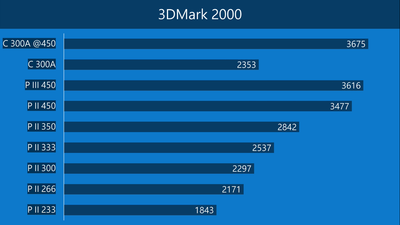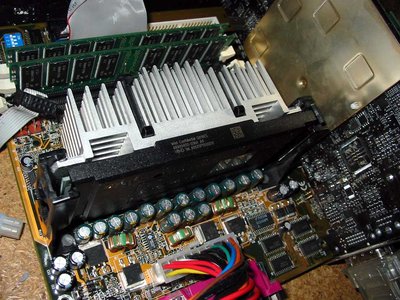First post, by athlon-power
- Rank
- Member
This poor build idea has transcended entire motherboards, cases, and CPUs. It's about to do that again. No, this will not end. Long after I am dead, it will gain sentience, and realize that a part in it was not made on February 22nd, 1999, at 05:26:42 GMT, and will try to find ways to gain locomotive abilities to replace the part.
It's been through a few phases- here's what I think it has been:
02/2018 v0.1: Biostar M6TWL, Pentium III Coppermine SL43E 600MHz, (?)MB PC-1xx RAM, no HDD, 3Com 3C905C-TX PCI, 52x CD-ROM (First vintage desktop I ever owned, PSU was screwed up and motherboard had bad caps so there wasn't much I could do with it. Case was yellowed to smithereens and had terrible cooling/airflow)
There were many variations between the original and the specs I first posted to vogons. It used the Tabor III I got over the summer, in the same case as v0.1. It used between 384 and 448MB of RAM, and often used an AGP FX 5200 256MB. I switched between the Coppermine and Katmai a couple of times before settling on the Katmai.
09/2018 v0.5: Gateway Tabor III, Pentium III Katmai SL35E 500MHz, 384MB PC-100 RAM, Crystal 4281 PCI, 3Com 3C905C-TX PCI, GeForce 2 MX 400 AGP, WD Caviar WD400 (This used the "new," fancy vintage mid-tower ATX case I got from my local pollution center- a nearby city with a huge chemical plant that in itself is as big as a small city- for US$20 after following a craigslist posting for it.
11/2018 v1: Intel SE440BX-2, Pentium III Katmai SL35E 500MHz, 192MB PC-100 RAM, AOpen Cobra AW744L II, ASUS AGP-3800M, WD Caviar WD400, 48x CD-ROM (First real build; Had some more significant issues, mainly that TNT2 M64, 64MB too much RAM, AOpen sound card, and HDD, but otherwise it was a decent build, and did alright)
12/2018 v1.1: Same as v1, except for a reduction to 128MB of RAM that has remained a staple of each variant of this build since then.
01/2019 v1.2: Same as v1, except that I installed an ATI Rage 128 Pro 16MB that I promptly killed via overclocking. Bought the Rage 128 when I realized the ASUS card was made in 2001.
02/2019 v1.3: Same as v1, except that I installed a TNT2 Pro 16MB in an attempt to get something faster than the AGP-V3800M, and the Rage 128 experience caused me to avoid ATI for a while.
04/2019 v1.4: Same as v1, except that I installed a Creative Labs 3D Blaster CT5823 to try to get even more time-accurate performance. This still remains my fastest pre-2001 video card. I also attempted a few experiments with DVD drives around this time, but stuck with the CD drive when the DVD drive that I had died.
07/2019: SE440BX-2 dies.
07/2019: Pentium III 500MHz SL35E dies.
After this, I re-built the system, and its specs changed a couple of times, though it was just CD/HDD/Sound Card stuff. Current specs:
Gateway Tabor III
Pentium III Coppermine SL43E
128MB PC-100
SoundBlaster Live! Value
3Com 3C905C-TX PCI
Creative Labs 3D Blaster CT5823
Quantum Fireball CR 6.4 AT
48x CD-ROM
TL;DR
I'm looking to revise my early to mid '99 build, with more time-accurate parts than what it has now. The parts in the list are what I currently own.
Here's what I'm planning now:
[UNDECIDED MOTHERBOARD, 440BX CHIPSET]
Intel Pentium III Katmai SL35D 450MHz [OR] Intel Pentium II Deschutes SL357 400MHz [OR] Intel Celeron Mendocino 333MHz SL2WN
128MB PC-100
SoundBlaster Live! Value
[UNKNOWN NETWORK CARD]
[POSSIBLY] ATI Rage 128 VR 8MB
[POSSIBLY] Quantum Fireball CR 6.4 AT
[UNKNOWN CD DRIVE]
Obviously, the processor choices I have dictate the direction of the build quite a bit. Celeron would be more budget-oriented, PII would be in the middle, and PIII would be at the top. Celeron and PII could place this machine in early 1999/mid 1999, whereas the PIII would place it in mid 1999.
RAM remains 128MB.
SoundBlaster Live! Value stays because I finally have an SB Live!, have been wanting one for 6.832 millenia.
The 3Com might be a bit new/fast for something like this. Think I have a D-Link PCI card that should fit nicely, given that it has the correct DOM.
The Rage 128 is very compelling for time-accuracy, but with that 8 megs of VRAM, not to mention how slow it likely is compared to my good TNT2's, it would be "Half Life Performance Issues," hell all over again.
Might keep the HDD. Might not.
Might keep the CD drive. Might not, though the CD drive was made in the summer of 2000, so eh.
might overclock the piss outta the celeron cuz i can, force 100mhz fsb and get that pentium ii performance for real cheap
rip se440bx-2, 1999-2019 https://www.youtube.com/watch?v=5NKMk8IpcV8
Where am I?

